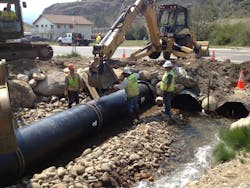Summit County, Colo., fixes flooding woes on busy road
More than 100 tributaries run through the southwest U.S. and drain into the 1,450-mile-long Colorado River. Corroded metal culverts designed to prevent flooding on roads crisscrossed by those streams are frequently the cause of it. For Colorado county road crews, flooding and washout caused by failing corrugated metal pipes (CMPs) beneath roads are a major problem—especially when that road affects one of the biggest areas for tourism in the state.
A culvert structure consisting of four CMPs underneath a busy road in Dillon, Colo., was severely corroded. Faced with the culverts’ imminent failure, the Summit County road crew needed to fix it as quickly and as cost-effectively as possible, with minimal disruption to the newly paved road above.
“The existing culvert was in critical shape and flow from the stream was being severely restricted, especially during high flow times,” said Russ Wosk, a Snap-Tite sales representative. “The water is constant. There is a short window to perform the work.”
John Polhemus, director of the Summit County Road and Bridge Department, found a solution with Snap-Tite. The county crew slip-lined three severely deteriorated culverts with a total of 280-ft of high density polyethylene (HDPE) pipe, and attached three HDPE Hydro-Bells to help increase inlet flow in times of high flow and potential flooding. Working independently of any contractors or outside assistance, the crew completed the entire project in less than a day and with no disruption of traffic or delays to residents.
“I’m glad I didn’t have to dig up a new road,” Polhemus said.
